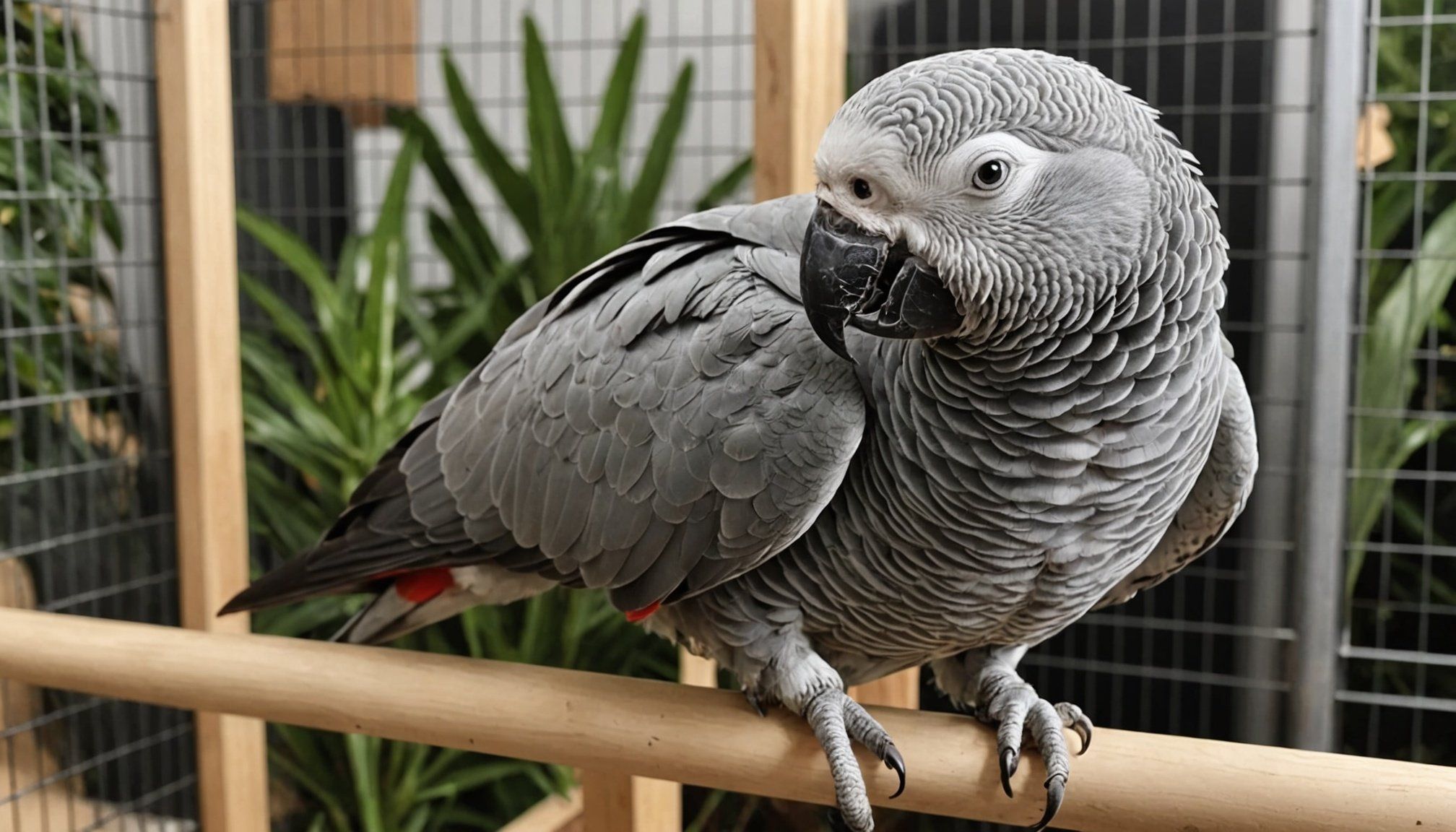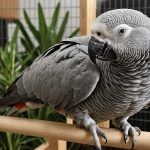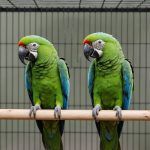Designing the Ideal Living Space for African Grey Parrots
Creating an ideal living space for African Grey Parrots is essential for their physical and mental health. These intelligent birds require a spacious environment that allows unrestricted movement. A spacious Designing Bird Environments ensures the parrot has enough room for flying and engaging in their natural behaviours, which is crucial for their well-being.
Selecting an appropriate cage size is also an important part of crafting a perfect Parrot Sanctuary. The cage should be large enough to accommodate not just the bird, but also toys and perches, allowing the parrot some exercise without having to leave its cage. Placement of the cage in a lively part of the home helps them to feel integrated into your daily life, as isolation could lead to boredom or anxiety.
Also to discover : Create a Spacious Sanctuary: Pro Tips for Welcoming Your Growing Maine Coon Kitten
Equally important is designing specific areas for play and exploration within your home. This includes setting up designated play zones with interactive toys and natural materials that encourage curiosity and stimulation.
By focusing on these elements, you can ensure that your parrot’s environment is enriching and meets their needs efficiently, allowing them to thrive both physically and mentally in their abode.
Also to see : Nurturing a Vibrant Home for Your Lone Parrot: Key Strategies for an Engaging and Enriching Environment
Safety Considerations for Parrots
Ensuring parrot safety in your home goes beyond providing adequate space and an enriching environment. One critical aspect is identifying and eliminating hazardous materials. Many toxic materials, such as Teflon-coated cookware, aerosol sprays, and certain houseplants like philodendron, can pose severe risks to your parrot. Keeping these out of reach or entirely opting for safer alternatives is paramount.
Bird proofing your home is another crucial step. This involves securing windows, covering wires, and blocking small crevices where a curious African Grey might explore unsafely. Securely fastening furniture and avoiding ceiling fans usage during free-flight time can prevent accidents, enhancing the overall safety.
When it comes to safe cage constructions, ensure that the materials are free from lead and zinc, which are harmful if ingested. Opt for stainless steel or powder-coated cages as these materials are non-toxic and highly durable. Consider cage modifications, such as adding safety locks and escape-proof doors to prevent accidental escapes.
By implementing these strategies, you can establish a safer, hazard-free environment for your African Grey Parrot, promoting their physical well-being and providing peace of mind.
Enrichment through Toys and Activities
Enriching the life of an African Grey Parrot requires more than just a sizeable Parrot Sanctuary; interactive toys and activities are essential for mental stimulation and preventing boredom. One key aspect of parrot enrichment involves offering a variety of toys that stimulate different senses. These could range from chewable items to puzzles that challenge their intellect.
Types of Toys for African Grey Parrots
Rotating various interactive toys can keep parrots engaged and curious. Toys that encourage foraging or mimicry are particularly effective, as they cater to the bird’s natural instincts. Consider toys with moving parts, mirrors, or those that allow them to investigate new textures.
DIY Enrichment Ideas
Crafting DIY projects offers creative and cost-effective ways to boost your parrot’s environment. Use household items like paper rolls or untreated wood blocks to build custom toys. Ensure materials used are safe and non-toxic, maintaining the parrot’s well-being.
Social Interaction and Playtime
Regular engagement with owners and other pets plays a vital role in parrot enrichment. Spend time daily interacting to strengthen bonds and offer quality social time. Facilitating interactions with family members also provides valuable diversity in their day-to-day experiences, contributing to their overall happiness.
Choosing the Right Materials for Parrot Habitat
Selecting the best materials for birds is crucial to ensure a safe and durable environment. Non-toxic and long-lasting options are recommended for cages, perches, and toys. For cages, stainless steel and powder-coated metals are ideal as they are robust and free from harmful substances like lead and zinc. These materials prevent the risk of poisoning, which is vital for your parrot’s health.
The choice of materials extends to perches and toys as well. Evaluating the safety of wood and plastics used in bird accessories is essential. Woods like untreated pine or maple are suitable options for perches, providing a natural feel without exposing your pet to any toxic oils or finishes. Similarly, avoid plastics that can easily break or splinter, posing a choking hazard.
Eco-friendly choices are increasingly popular, allowing parrot owners to support sustainability without compromising safety. Natural materials like sisal, cotton, and hemp offer safe, biodegradable options for toys and other bird accessories. These choices not only ensure the well-being of African Greys but also contribute positively to the environment, aligning with growing ecological concerns. By prioritizing durable and non-toxic essentials, you create a nurturing habitat that supports both health and sustainability.
Creating a Multi-Dimensional Environment
To enhance your African Grey Parrot’s habitat, focus on utilizing vertical space and building habitat complexity. This practice is crucial for offering a dynamic living environment that satisfies their innate behaviours. African Greys are natural explorers; thus, incorporating vertical elements like ropes and branches encourages climbing and exploration.
Integrating natural components, such as safe branches, ropes, and even non-toxic plants, enriches their environment. These additions not only fulfil physical activity needs but also engage their senses. Using a variety of textures stimulates them mentally and prevents boredom by offering diverse experiences.
Meanwhile, enhancing sensory experiences through varied lighting, sounds, and textures further contributes to their mental enrichment. For example, placing the cage in an area that receives natural sunlight can improve their mood and vitality. Introducing sounds, like gentle music, can simulate their natural habitat sounds and keep their environment vibrant.
By developing a multi-dimensional space that includes climbing structures and natural materials, owners can enrich their parrot’s experience at home. This approach helps African Grey Parrots thrive by mirroring the challenges and stimulants they would encounter in the wild, promoting both physical health and mental resilience.
Establishing Routine and Stability
A consistent parrot routine is essential for fostering mental stability in African Grey Parrots. Predictability supports a sense of security, which is crucial for these intelligent birds. Crafting a schedule involves organizing regular feeding times, play, and social interactions, promoting an environment where your parrot can thrive.
Start by setting fixed times for meals. Consistency in feeding helps to maintain their dietary health, preventing unnecessary stress. Integrating play and exercise at set intervals contributes to their physical wellness. Allocate time daily for social interactions, whether it’s through talking, playing, or simply being present. This engagement helps reduce anxiety and boredom.
Maintaining a stable routine also involves monitoring behavioural changes. For example, sudden aggression or withdrawal might indicate stress or environmental discomfort. Observing these changes allows you to assess the environmental impact on their well-being, facilitating adjustments where necessary.
By emphasizing the establishment of a structured routine, parrot owners can support both the psychological and physical health of their birds. The comfort of a stable environment is a foundational aspect of responsible parrot care, ensuring that your avian companion feels secure and content in their surroundings.
Expert Tips and Insights
Caring for African Grey Parrots requires a nuanced understanding of their needs, and insights from seasoned professionals and parrot owners can offer invaluable guidance. Avian veterinarians highlight the importance of a structured routine, emphasizing that predictability can significantly enhance a parrot’s mental stability. Regular assessments of diet, space utilization, and enrichment activities are recommended to ensure comprehensive care.
Parrot owners with years of experience often share practical advice on managing daily challenges. One common suggestion is rotating toys and implementing DIY enrichment projects to keep the birds engaged. Additionally, setting up vertical climbing structures can promote natural behaviours and prevent boredom.
Behaviourists advise monitoring for changes in mood or activity levels, which might indicate underlying health or environmental issues. By staying attuned to these signals, owners can provide timely interventions, such as adjusting the environment or seeking professional advice.
Community forums and support groups offer platforms for sharing experiences and solutions. Topics like crafting an enriching Parrot Sanctuary or integrating safe materials in parrot habitats frequently arise, providing practical tips for new and seasoned owners alike. Engaging with these resources fosters a supportive network dedicated to advancing exceptional parrot care practices.











